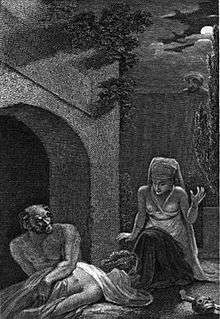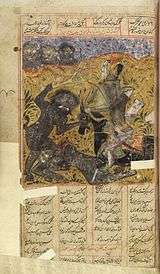Ghoul

A ghoul is a demon or monster originating in pre-Islamic Arabian religion associated with graveyards and consuming human flesh. It also appears in Islamic mythology.[1] In modern fiction, the term has often been used for a certain kind of undead monster.
By extension, the word ghoul is also used in a derogatory sense to refer to a person who delights in the macabre, or whose profession is linked directly to death, such as a gravedigger or graverobber.
Early etymology
Ghoul is from the Arabic غُول ghūl, from غَالَ ghāla, "to seize".[2] In Arabic, the term is also sometimes used to describe a greedy or gluttonous individual.
The term was first used in English literature in 1786, in William Beckford's Orientalist novel Vathek,[3] which describes the ghūl of Arabic folklore. This definition of the ghoul has persisted until modern times, with ghouls appearing in popular culture.[4]
Folklore

In the Arabic folklore, the ghūl is said to dwell in cemeteries and other uninhabited places. The ghūl subsequently was understood as a fiendish type of jinn believed to be sired by Iblis in Islam.[5] A male ghoul is referred to as ghūl while the female is called ghulah.[6] A source identified the Arabic ghoul as a female creature who is sometimes called Mother Ghoul (umm ghūla) or a relational term such as Aunt Ghoul.[7] She is portrayed in many tales luring hapless characters, who are usually men, into her home where she can eat them.[7]
Some state that a ghoul is a desert-dwelling, shapeshifting demon that can assume the guise of an animal, especially a hyena. It lures unwary people into the desert wastes or abandoned places to slay and devour them. The creature also preys on young children, drinks blood, steals coins, and eats the dead,[8] then taking the form of the person most recently eaten. One of the narratives identified a ghoul named Ghul-I-Beaban, a particularly monstrous character believed to be inhabiting the wilderness of Afghanistan and Iran.[9]
It was not until Antoine Galland translated One Thousand and One Nights into French that the western idea of ghoul was introduced into European society. Galland depicted the ghoul as a monstrous creature that dwelled in cemeteries, feasting upon corpses.
Ghouls (Persian: غول) also exist in Persian mythology.
See also
References
- ↑ "The Story of Sidi-Nouman". Retrieved 2012-07-05.
- ↑ Robert Lebling (30 July 2010). Legends of the Fire Spirits: Jinn and Genies from Arabia to Zanzibar. I.B.Tauris. pp. 96–. ISBN 978-0-85773-063-3.
- ↑ "Ghoul Facts, information, pictures | Encyclopedia.com articles about Ghoul". Encyclopedia.com. Retrieved 2011-03-23.
- ↑ Al-Rawi, Ahmed K. (11 November 2009). "The Arabic Ghoul and its Western Transformation". Folklore. 120 (3): 291–306. doi:10.1080/00155870903219730.
- ↑ "ghoul". Encyclopædia Britannica. Retrieved January 22, 2006.
- ↑ Steiger, Brad (2011). The Werewolf Book: The Encyclopedia of Shape-Shifting Beings. Canton, MI: Visible Ink Press. p. 121. ISBN 9781578593675.
- 1 2 Reynolds, Dwight (2015). The Cambridge Companion to Modern Arab Culture. Cambridge: Cambridge University Press. p. 260. ISBN 9780521898072.
- ↑ "ghoul". Merriam-Webster Online Dictionary. Retrieved January 22, 2006.
- ↑ Melton, J Gordon (2010). The Vampire Book: The Encyclopedia of the Undead. Canton, MI: Visible Ink Press. p. 291. ISBN 9781578592814.